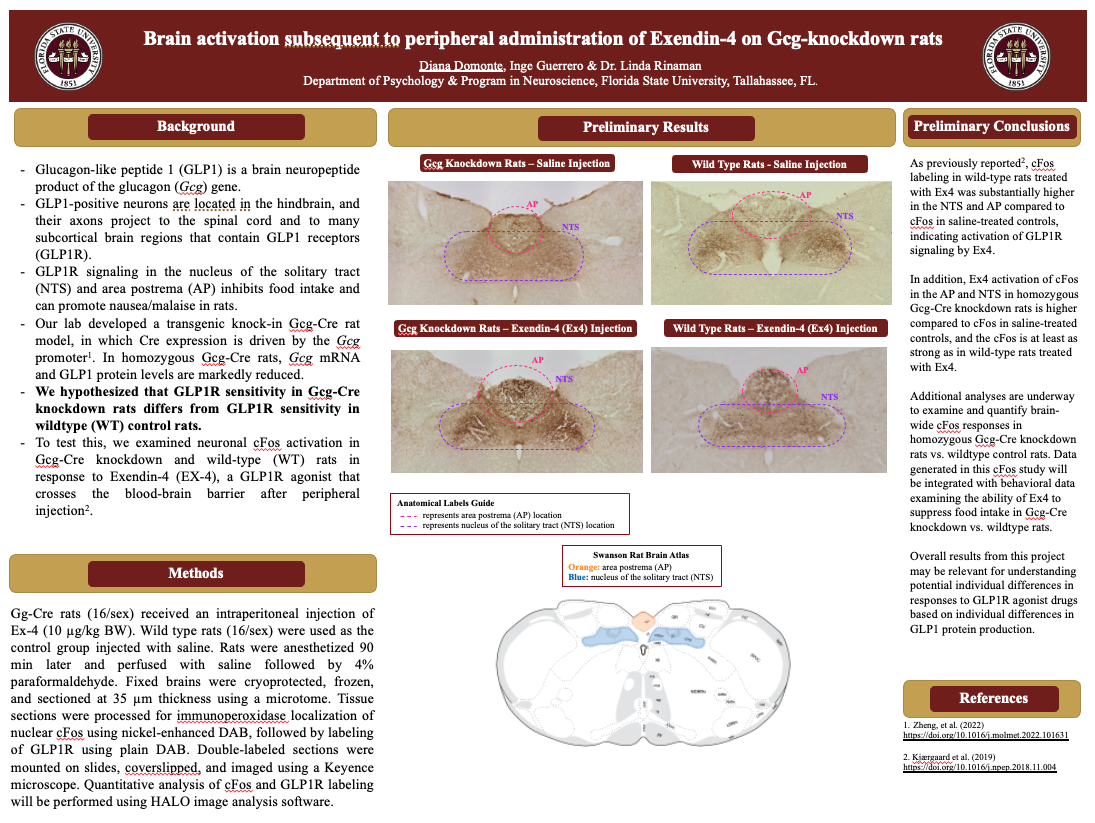Research Symposium
24th annual Undergraduate Research Symposium, April 3, 2024
Diana Domonte Poster Session 1: 9:30 am - 10:30 am /49

BIO
Hello! I'm Diana Domonte, a Venezuelan undergraduate student majoring in behavioral neuroscience with a minor in chemistry. My current interests include sleep disorders, the impact of stress on physiology and behavior, neurobiological mechanisms in relation to metabolic functions, and neurodegenerative diseases. Currently, I'm working as an undergraduate research assistant for Dr. Linda Rinaman. Beyond academics, I enjoy dancing and reading.
Brain activation subsequent to peripheral administration of Exendin-4 on Gcg-knockdown rats
Authors: Diana Domonte, Linda RinamanStudent Major: Behavioral Neuroscience
Mentor: Linda Rinaman
Mentor's Department: Psychology Mentor's College: Arts and Sciences Co-Presenters:
Abstract
Glucagon-like peptide 1 (GLP1) is a brain neuropeptide product of the glucagon (Gcg) gene. GLP1 binds to GLP1 receptors (GLP1R) located throughout the brain, and is critical for regulating autonomic functions, food intake, and other motivated behaviors. Our lab discovered that transgenic homozygous knock-in rats that express Cre driven by the Gcg promoter (Gcg-Cre rats) have markedly less Gcg mRNA and GLP1 protein, making them a useful GLP1 knockdown model. However, exendin-4 (Ex4), a GLP1R agonist that acts in the brain after peripheral injection, should still activate neurons that express GLP1R in these knockdown rats. The present study examines brain-wide cFos responses in Gcg-Cre knockdown rats and wild-type rats after peripheral injection of Ex4 to test the hypothesis that GLP1R sensitivity differs between genotypes. A total of 32 Gcg-Cre rats were injected i.p. with 10 µg/kg of Ex4 and then anesthetized and perfused 90 min later with saline followed by 4% paraformaldehyde. Fixed brains were then frozen and sectioned at 35 µm using a microtome, and subsequently double-immunolabeled using rabbit-anti-cFos and mouse-anti-GLP1R. Labeled tissue sections were mounted on slides, coverslipped, and imaged using a Keyence microscope. Analyzed regions will include brainstem, thalamic, hypothalamic, and forebrain regions that express GLP1R. However, results and conclusions from this study are still pending as we analyze imaged labeling data using HALO software for quantitative analysis. The results will be relevant to understanding potential individual differences in responses to GLP1R agonist drugs based on individual differences in GLP1 protein production.
Keywords: Glucagon-like peptide 1 (GLP1), cFos responses, food intake inhibition, GLP1R agonist drugs


